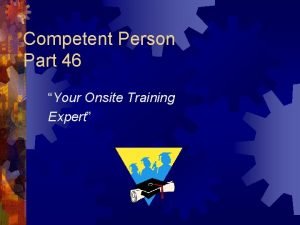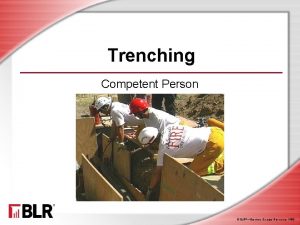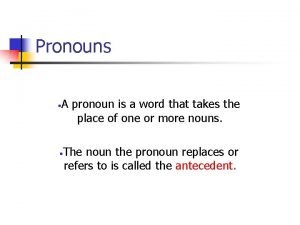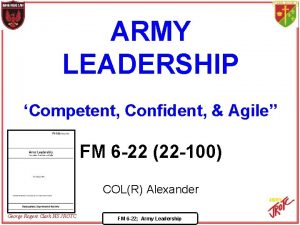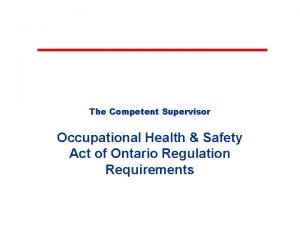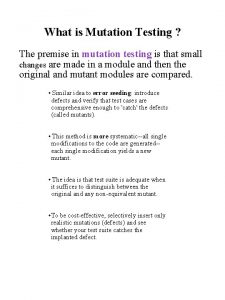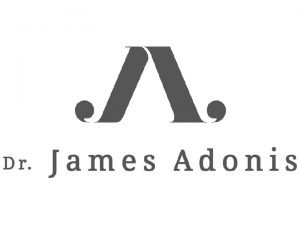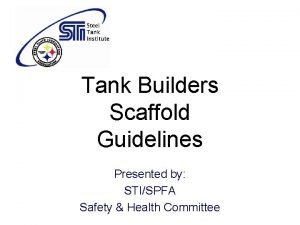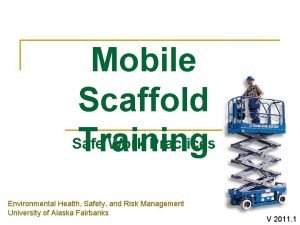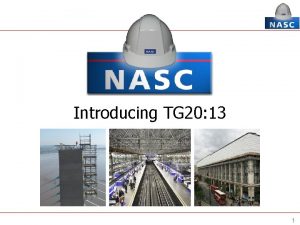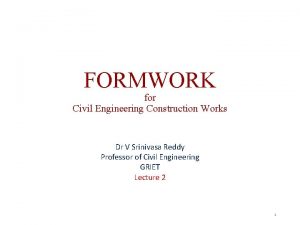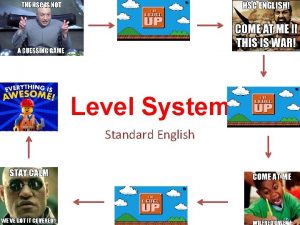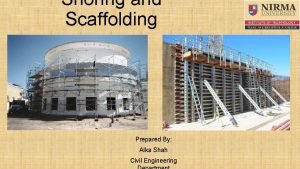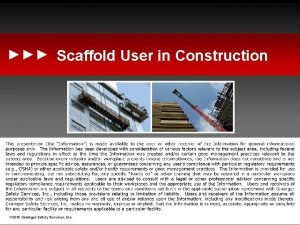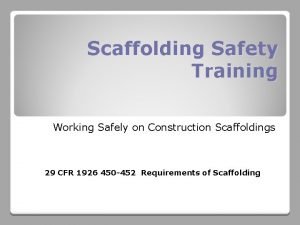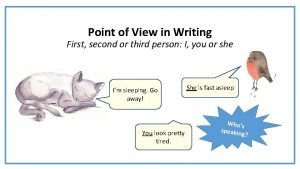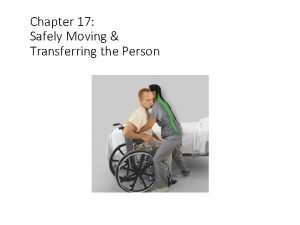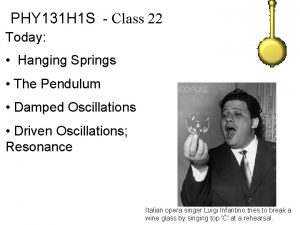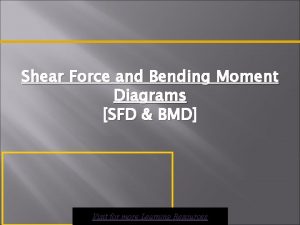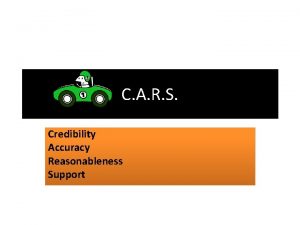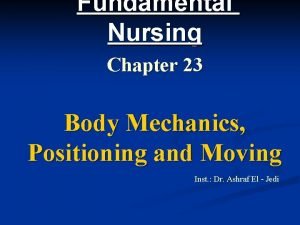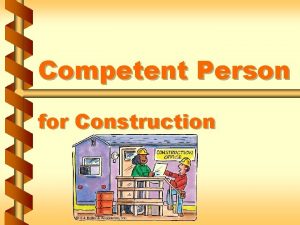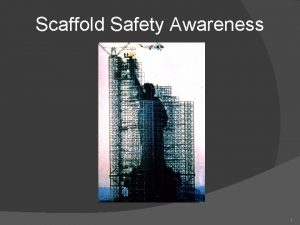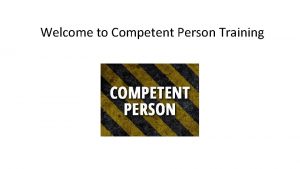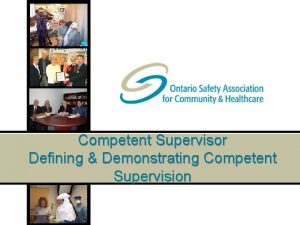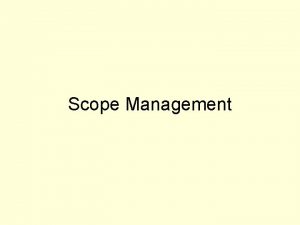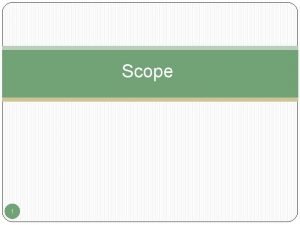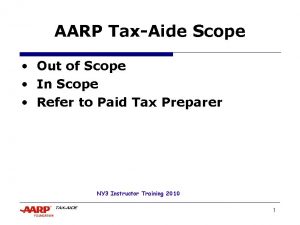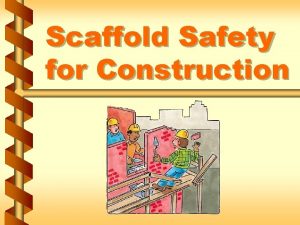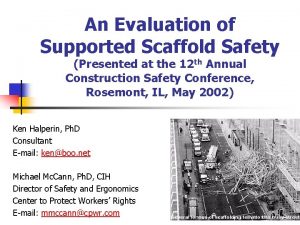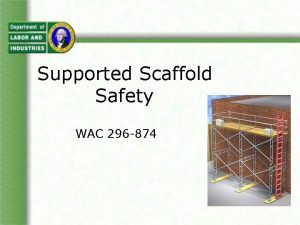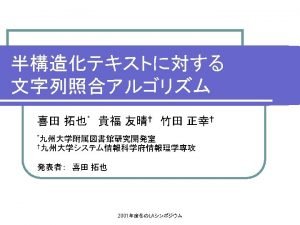Supported Scaffold Competent Person Overview Scope and Training













































































- Slides: 77

Supported Scaffold Competent Person

Overview • Scope and Training • Scaffold Erection • Safe Use Falls from scaffolds injure 4, 500 and kill • Dismantling 50 workers every year! • Other Types • Test (based on 1926. 450)

References • 29 CFR 1926, Subpart L • 29 CFR 1910, Subpart D • Scaffold Training Institute You will need a copy of this standard for this course. Print out a copy of the standard from the “Course Document” section or contact EHSS at 540 -231 -2341 prior to beginning the course.

Training • Scaffold User – 1 -hour Awareness – uses or accesses the scaffold, but does not participate in the erection, alteration, or supervision of the scaffold • Scaffold Erector – 3 -hour Competent Person Class – directly supervises employees erecting, moving, dismantling, or altering a scaffold

Training • Retraining is required whenever: – there is a lack of skill or understanding, – there are changes in the worksite, – there are changes in the types of scaffolds, fall protection, or falling object protection, or – actions indicate a need for retraining.

Competent vs. Qualified • Supervises erection, moving, dismantling, alteration • Determines fall protection for erection/dismantling • Inspects • Rectifies unsafe scaffold conditions • Designs scaffolds • Determines anchor points for fall protection

Step 1: Preparation Consider the following: ü What is the intended use? • • • what work tasks are involved anticipated loads (materials & equipment) how many people will be on it unique building configurations obstructions, such as electrical or piping

Step 1: Preparation Consider the following: ü What are the site conditions? • debris to be cleared • uneven grade/slopes to consider • foundation type • soil conditions • concrete foundation • pavement/asphalt foundation • weather conditions A scaffold leg broke through this city sidewalk. . .

Step 1: Preparation ü How high will the scaffold be? • will scaffold need to be secured or designed by a qualified person ü What work will be performed on it? • welding or heat-producing tasks • how many people will be on the scaffold ü Will pedestrians be affected? • building accesses must be maintained • overhead protection may be required

Step 2: Proper Erection ü Erect, alter, move, and dismantle under the supervision of a competent person! ü Build to OSHA standards. ü Use the appropriate fall protection system for the situation. Scaffolding should always be built as complete as possible “missing parts” is no excuse!

OSHA Standards • • • Platforms/decking Securing the scaffold Base/footing Plumb, level, and square Proper access Safe use requirements Refer to your copy of the OSHA standard (1926. 450) for requirements. The standard number will be referenced (at the top) on following slides.

Platforms/Decking 1926. 451 • (b)(1) shall be fully planked or decked. • (b)(1)(i) space between planks and space between platform and uprights cannot exceed 1” (except where necessary). • (b)(1)(ii) remaining open space between the platform and uprights cannot exceed 9 1/2”. • (b)(2) platforms and walkways must be at least 18” wide (refer to standard for exceptions).

Platforms/Decking 1926. 451(b) 1. cracks in boards 2. excessive gaps between boards 3. not scaffold grade planks

Platforms/Decking 1926. 451(b)(3) • (b)(3) platform shall not be more than 14” from the face of the work unless fall protection is provided. • (i) 3” for outriggers • (ii) 18” for plastering and lathing operations

Platforms/Decking 1926. 451(b)(4) • Each end of the platform, unless cleated or restrained by hooks or equivalent means, shall extend over the centerline of its support at least 6”.

Platforms/Decking 1926. 451(b)(5) • If the plank is 10’ long or less, it cannot extend more than 12” past the support. • If the plank is longer than 10’, it cannot extend more than 18” past the support. Additional protection is required if the planks do extend more that the limits specified above.

Platforms/Decking 1926. 451(b)(7) • Where platforms overlap to create a long platform, the overlap shall occur only over supports, and shall not be less than 12” unless nailed together.

Platforms/Decking 1926. 451(b)(8) • Where platform changes direction, any platform that rests on a bearer at an angle other than a right angle, shall be laid first, and platforms which rest at right angles over the same bearer shall be laid second, on top of the first platform. The result is, the ends of the top planks form a straight line, rather than saw-toothed, which reduces tripping hazards. This example is incorrect!

Platforms/Decking 1926. 451(b)(9) - (11) • (b)(9) Do not paint wooden platforms. • They can be treated periodically with clear preservatives, fire-retardants, and slip-resistant finishes. • (b)(10) Do not mix scaffold components by different manufacturers unless they fit together without force. • (b)(11) Do not use scaffold components of dissimilar metals unless the competent person has determined that galvanic action will not reduce the strength of any components.

Platforms/Decking • Planks may be: • • solid sawn wood manufactured steel manufactured aluminum • If solid sawn wood is used, it must be scaffold grade. Southern pine is the most popular, and Dense Industrial 65 is the minimum grade as determined by the Southern Pine Inspection Bureau.

Securing 1926. 451(c)(1) • Scaffolds with a height to base width ration of more than 4: 1 shall be restrained from tipping by guying, typing, bracing, or equivalent means. – (i) Guys, ties, and braces shall be installed where horizontal members support both inner and outer legs.

Securing 1926. 451(c)(ii) • If the base width is wider than 3’, the first tie will be a vertical distance of 4 times that (from the ground), and every 26’ thereafter. • Example: • base width = 5’ • first vertical tie will be (5’ x 4) 20’ from the ground

Securing 1926. 451(c)(ii) • If the base width is 3’ or narrower, the first tie will be a vertical distance of 4 times that (from the ground), and every 20’ thereafter. • Example: • base width = 3’ • first vertical tie will be (3’ x 4) 12’ from the ground

Securing 1926. 451(c)(ii) • Guys, ties, and braces shall be installed at each end of the scaffold and at horizontal intervals not to exceed 30’. For example, on this scaffolding which extends the length of the hotel, horizontal braces will be installed at the red marks. x x 30’ x <30’ x 30’

Securing Brace to keep the scaffold from falling into the wall and tie to keep the scaffold from falling away from the wall.

Base/Footing 1926. 451(c)(2) • Supported scaffold poles, legs, posts, frames, and uprights shall bear on base plates and mud sills or other adequate firm foundation. mud sill base plate

Mud Sill Size Most scaffolds 4 levels or less in height Larger scaffolds on Type A Soil Larger scaffolds on Type B Soil Larger scaffolds on Type C Soil 2” x 10” pad, 12” - 18” long 2” x 10” pad, 18” long 18” square pads 36” square pads

Base/Footing 1926. 451(c)(2)(i) • The base and sill must provide a solid surface for the feet to sit upon so that the scaffold doesn’t sink, move, settle, or shift. The base plate is missing in this example, and screw jacks should be used to level the scaffold instead of layering old mud sills.

Base/Footing 1926. 451(c)(2)(ii) • Unstable objects shall not be used to support scaffolds or platform units. • • bricks cinderblocks buckets scrap lumber, etc.

Screw Jacks • Screw jacks are used to level the scaffold. • Maximum extension is 18” in height. Some screw jacks will have a built in stop so that the 18” cannot be exceeded. adjusting “nut” “screw” base plate

Plumb, Level, and Square 1926. 451(c)(3) • Supported scaffold poles, legs, posts, frames, and uprights shall be plumb (perfectly vertical) and braced to prevent swaying and displacement. Crossbracing is required on both front and back of each scaffold frame. crossbracing

Plumb, Level, and Square 1926. 451(c)(3) • Use a level on two opposite uprights to check for plumb. • Use a level on a bearer (horizontal) to check for level. Notice the uneven, cluttered foundation. . .

Plumb, Level, and Square 1926. 451(c)(3) • Use a tape measure to check for “square” by measuring the distance between opposite corners. The measurements should be equal. A D C B

Access 1926. 451(e)(2) • Ladders must meet OSHA design and use criteria 1926, Subpart X. • secured at top and bottom • extend 3’ above landing • Ladders must be positioned so as not to tip the scaffold.

Access 1926. 451(e)(2) • Hook-on and attachable ladders shall be positioned so that their bottom rung is not more than 24” above the supporting level.

Access 1926. 451(e)(2) & (6)(i) • The manufacturer must specify that the frame of the scaffold was built for access! (Even if it looks like a ladder has been built into the frames, it may be support bracing. ) • Ladders must have a rest platform every 35’. • Rungs must be at lest 11 1/2” wide (8” for ladders built into the frame). • Rung spacing must be uniform and cannot exceed 16 3/4” between rungs.

Access 1926. 451(e)(3) & (4) • Stairtowers must have hand midrails on each side of the stairway. • Stairs must be at least 18” wide and have a landing platform at least 18” long at each level. • Treads must be slip resistant. • Stair angle must be between 40 and 60 degrees from the horizontal. • Riser height must be uniform.

Step 3: Safe Use ü Maximum Capacity ü Inspection ü Electrical clearances ü Snow, ice, mud ü Storms, high winds ü Debris ü Working level height ü Fall Protection ü Falling Object Protection

Maximum Intended Load 1926. 451(a)(1) • Each scaffold and scaffold component shall be capable of supporting, without failure, its own weight and at least 4 times the maximum intended load applied or transmitted to it. Maximum Intended Load = the total of all persons, equipment, tools, materials, transmitted loads, and other loads reasonably anticipated to be applied to a scaffold or scaffold component at any one time.

Rated Load Capacity 1926. 451(f)(1) • Scaffolds and scaffold components shall not be loaded in excess of their maximum intended load or rated capacity, whichever is less. Rated Load = the manufacturer’s specified maximum load to be applied to a scaffold or scaffold component.

Rated Load Capacity of scaffold Intended Load should be Light-duty “standard” Medium-duty “brick masons” Heavy-duty “stone-setters” 25 pounds per square foot applied uniformly 50 pounds per square foot applied uniformly 75 pounds per square foot applied uniformly

Maximum Capacity • To determine the maximum weight that can be applied to the scaffold, determine the square footage and multiply it by the manufacturer’s rated load capacity. – Example: scaffold size is 7’ x 5’ = 35 sq. ft. – 35 x 25 psf (light-duty) = 875 pounds Persons are estimated at 250 pounds by industry standard. Three workers, plus another 125 pounds will be allowed on this scaffold.

Maximum Capacity 1926. 451(f)(16) • Platforms shall not deflect more than 1/60 of the span when loaded. • Example: span = 10’ ( or 120” ) • 120”/60 = 2” maximum deflection (or bowing of the board under the weight)

Inspection 1926. 451(f)(3) • The Scaffold Competent Person must inspect the scaffold: – before each shift – after an occurrence which could affect the scaffold’s integrity • Check for visual defects, such as: – – bent or damaged components missing guardrails or crossbracing foundation remains solid and firm proper access

Repair Procedures 1926. 451(f)(4) • The Scaffold Competent Person should be notified immediately if a component becomes damaged after the scaffold has been erected. The scaffold must not be used until the damaged component has been properly repaired or replaced, or braced to meet those provisions, or removed from service.

Electrical 1926. 451(f)(6) • You must be very careful when any of the following are in the vicinity of power lines! • • tools/equipment you are using materials you are handling any scaffold component any part of your body Contact the power company ahead of time for safety precautions to be implemented!

Insulated Line Clearances 1926. 451(f)(6) Voltage Minimum Distance < 300 volts 3 feet Alternative 300 v to 50 kv 10 feet > 50 kv 10 feet plus 4 2 times the inches/1 kv length of the over 50 kv line insulator but never less than 10 feet.

Uninsulated Line Clearances Voltage Minimum Distance < 50 kv 10 feet > 50 kv Alternative 10 feet plus 4 2 times the inches/1 kv length of the over 50 kv line insulator but never less than 10 feet.

Electrical 1926. 451(f)(6) • If a scaffold must be erected in an area where power lines enter a building, the power company: • may be able to deenergize the lines, or • will guard and insulate the lines.

Working Conditions 1926. 451(f)(8) • Employees shall be prohibited from working on scaffolds covered with snow, ice, or other slippery material, except as necessary to remove such materials.

Working Conditions 1926. 451(f)(12) • Work on or from scaffolds is prohibited during storms or high winds UNLESS a competent person had determined that it is safe for employees to be on the scaffold, and those employees are protected by personal fall arrest systems or wind screens. – Wind screens shall not be used unless the scaffold is secured against the anticipated wind forces. – Where uplift can occur which would displace scaffold end frames or panels, they shall be locked together vertically by pins or equivalent.

Working Conditions 1926. 451(f)(13) • Debris shall not be allowed to accumulate on platforms. – scrap material – mortar – demolition materials

Working Conditions 1926. 451(f)14) • Makeshift devices, such as but not limited to boxes and barrels, shall not be used on top of scaffold platforms to increase the working level height of employees.

Fall Protection 1926. 451(g)(1) • Each employee on a scaffold more than 4’ at VT (OSHA says 10’) above a lower level shall be protected from falling to that lower level. Always build the scaffold as complete as possible!

Fall Protection 1926. 451(g)(4)(i) • Guardrail systems shall be installed along all open sides and ends of platforms before being released for use by employees other than erection/dismantling crews. • Exception: within 14” of the face of the work.

Fall Protection 1926. 451(g)(4)(ii) & (vii) • Toprails (manufactured after 1/1/2000) must be between 38” - 45” above the platform surface. • Before 1/1/2000, between 36” - 45”. Toprails must be capable of supporting 200 lbs. applied in an downward or outward direction.

Fall Protection 1926. 451(g)(4)(iv) & (ix) • Midrails shall be installed at a height of approximately midway between the top edge of the toprail and the platform surface. Midrails must be capable of supporting 150 lbs. applied in an downward or outward direction.

Fall Protection 1926. 451(g)(4)(xv) • Crossbracing is acceptable in place of a midrail when the crossing point of two braces is between 20” - 30” above the work platform.

Fall Protection 1926. 451(g)(4)(xv) • Crossbracing is acceptable in place of a toprail when the crossing point of two braces is between 38” - 48” above the work platform. It cannot serve as both!

Fall Protection 1926. 451(g)(2) • Effective 9/2/1997, the employer shall have a competent person determine the feasibility and safety of providing fall protection for employees erecting or dismantling supported scaffolds. • Employers are required to provide fall protection for employees erecting or dismantling supported scaffolds where the installation and use of such protection is feasible and does not create a greater hazard.

Fall Protection 1926. 451(g)(3) • Personal fall arrest systems used on scaffolds (when the guardrail system does not protect you) shall be attached by lanyard to: • vertical lifeline (1 st choice), • horizontal lifeline (2 nd), or • scaffold structural member

Falling Object Protection 1926. 451(h)(1) • In addition to hard hats, each employee on a scaffold shall be provided with additional protection from falling hand tools, debris, and other small objects through the installation of: – – – barricades toe boards screens debris nets catch platforms canopy structures

Falling Object Protection 1926. 451(h)(1) • When falling objects are too large, heavy or massive to be contained or deflected by such measures, the employer shall place the objects away from the edge and secure the materials as necessary.

Falling Object Protection 1926. 451(h)(2) • Paneling or screening is required where tools, materials, or equipment are piled higher than the top edge of the toeboard.

Falling Object Protection 1926. 451(h)(4) • Toeboards shall withstand 50 lbs. of force applied in a downward or outward direction. – At least 3 1/2” high – securely fastened – not more than 1/4” clearance above the platform – solid or with openings no greater than 1”

Step 4: Disassembly This picture shows bamboo scaffolding typically used in Asia. A common method of dismantling this type of scaffold when work is completed is to light it on fire and burn it down! In case you’re wondering. . . VT does not permit or endorse this method!

Step 4: Disassembly ü Check scaffolding to see if it has been structurally altered in any way which would make it unsafe. ü Reconstruct, if necessary, before dismantling. ü Use proper access. ü Dismantle from the top down. ü Lower components by handing down or lowering with a rope - do not throw down! ü Stockpile in orderly manner.

Fabricated Frames 1926. 452(c)(3) • Frames and panels shall be joined together vertically by coupling or stacking pins (or equivalent means). rivet pin with cotter hinge pin snap pin

Fabricated Frames 1926. 452(c)(6) • Scaffolds over 125’ in height above their base plates shall be designed by a registered professional engineer (i. e. “qualified person”).

Mobile Scaffolds 1926. 452(w)(2) • Scaffold casters and wheels shall be locked with positive wheel and/or wheel and swivel locks to prevent movement of the scaffold while the scaffold is used in a stationary manner. Do not use casters with defective braking devices.

Mobile Scaffolds 1926. 452(w)(3) • Manual force used to move the scaffold shall be applied as close to the base as practical, but not more than 5’ above the supporting surface.

Mobile Scaffolds 1926. 452(w)(6) • Employee shall not be allowed to ride on scaffold unless the following conditions exist: 1. The surface on which the scaffold is being moved is within 3 degrees of level, and free of pits, holes, and obstructions. 2. The height to base width ration of the scaffold during movement is 2: 1 or less.

Mobile Scaffolds 1926. 452(w)(6) • continued. . . 3. Outrigger frames, when used, are installed on both sides of the scaffold. 4. When powered systems are used, the force is applied directly to the wheels and does not produce a speed of 1 foot per second. 5. Employees are within the guardrail system.

Mobile Scaffolds 1926. 452(w)(8) & (9) • Screw jacks shall be used to level the scaffold, where necessary. • Caster stems and wheel stems shall be pinned or otherwise secured in scaffold legs or adjustment screws.

Mobile Scaffolds • Maintain housekeeping in the area. A welding rod or electrical cord is enough to tip a mobile scaffold over!

Shore or Lean-to Scaffolds 1926. 451(f)(2) • Lean-to: a supported scaffold which is kept erect by tilting it toward and resting it against a building or structure. • Shore: a supported scaffold which is placed against a building or structure and held in place with props.

Review ü Competent person on site ü Build per OSHA regulations ü Provide proper access ü Require appropriate fall protection ü Only use as intended and allowed ü Orderly dismantlement
 Fall protection competent person training ppt
Fall protection competent person training ppt Scaffold footing
Scaffold footing What is second lerson
What is second lerson Competent persons report
Competent persons report Cimah 1996
Cimah 1996 Define competent person
Define competent person Competent person definition
Competent person definition 2 person singular
2 person singular Person person = new person()
Person person = new person() First person second person third person chart
First person second person third person chart Fm6-22
Fm6-22 Fascia and gutter scaffold
Fascia and gutter scaffold Child and adolescent development and facilitating learning
Child and adolescent development and facilitating learning Burl and paul have a total weight of 1300 n
Burl and paul have a total weight of 1300 n Expense prefix and suffix
Expense prefix and suffix Competent supervision meaning
Competent supervision meaning Elements of intercultural competence
Elements of intercultural competence What makes a competent communicator?
What makes a competent communicator? Competent authority
Competent authority Spc 1017
Spc 1017 Competent authority
Competent authority Antonym competent
Antonym competent Competent programmer hypothesis
Competent programmer hypothesis Listening competency
Listening competency Personal humility
Personal humility Competent intercultural communicators resist ambiguity.
Competent intercultural communicators resist ambiguity. Havisten competent
Havisten competent Competent kids, caring communities
Competent kids, caring communities Lovable fool
Lovable fool Culturally competent counselor
Culturally competent counselor Competent cell이란
Competent cell이란 Product scope vs project scope
Product scope vs project scope Io2br3
Io2br3 Scaffolding support in tank
Scaffolding support in tank Why does dimmesdale go to the scaffold
Why does dimmesdale go to the scaffold Sole plate scaffolding
Sole plate scaffolding Mobile scaffold accident
Mobile scaffold accident Independent scaffold diagram
Independent scaffold diagram Column shuttering work
Column shuttering work Post-drupal-scaffold-cmd
Post-drupal-scaffold-cmd Business studies business report example
Business studies business report example Cariotipo del maiz
Cariotipo del maiz Feature article scaffold
Feature article scaffold Petal scaffold
Petal scaffold Txxxc paragraph structure example
Txxxc paragraph structure example Statue of liberty scaffold
Statue of liberty scaffold Single flying shore
Single flying shore Resorbable stent
Resorbable stent Scaffold terminology
Scaffold terminology Pump jack scaffold must be fitted with two
Pump jack scaffold must be fitted with two A brick falls freely from a high scaffold
A brick falls freely from a high scaffold Person-job fit and person-organization fit
Person-job fit and person-organization fit Person a and person b
Person a and person b Etc in formal writing
Etc in formal writing First person vs third person writing
First person vs third person writing Fahrenheit 451 external conflict
Fahrenheit 451 external conflict Public class person private name
Public class person private name Chapter 18 safely moving the person
Chapter 18 safely moving the person What are the features of a biography
What are the features of a biography One person's trash is another person's treasure
One person's trash is another person's treasure When moving a person in segments what do you move first
When moving a person in segments what do you move first Soldier's heart answer key
Soldier's heart answer key A person swings on a swing when the person sits still
A person swings on a swing when the person sits still Hi, how are you doing
Hi, how are you doing Draw the sfd and bmd
Draw the sfd and bmd Credibility accuracy reasonableness and supported
Credibility accuracy reasonableness and supported Wellcome to my presentation
Wellcome to my presentation No video with supported format and mime type
No video with supported format and mime type Industrialists of the late 1800s used pools and trusts to
Industrialists of the late 1800s used pools and trusts to Responsible person training
Responsible person training مثال على opinion paragraph
مثال على opinion paragraph Matrix supported conglomerate
Matrix supported conglomerate What is generalization
What is generalization What is a broad generalization
What is a broad generalization Sims fowler position
Sims fowler position Types of supporting details
Types of supporting details Pettijohn classification
Pettijohn classification Computer supported collaborative work
Computer supported collaborative work





